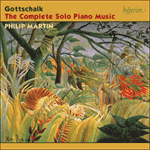The key of this lament (‘con malinconia’ instructs Gottschalk) is appropriately sombre E flat minor. After a recitativo introduction, the melody, which could pass for a minor-key variation on
Bobby Shaftoe but is actually a Louisiana folk song known as
Lolotte or
Pov’ piti Lolotte, proceeds with knell-like tolling in the bass, invested with increasingly lavish treatment, until the sparse coda. The final fff arpeggio flourish, at odds with the rest of the piece, looks suspiciously like applause-garnering.
from notes by Jeremy Nicholas © 1994
Le mode de cette lamentation («con malinconia» est l’indication de Gottschalk) est approprié: un sombre mi bémol mineur. Après une introduction en recitativo, la mélodie, qui pourrait passer pour une variation en mineur sur la vieille chanson
Bobby Shaftoe, mais qui est en fait une chanson folklorique de Louisiane connue sous le nom de
Lolotte ou
Pov’ piti Lolotte, est accompagnée d’un son de glas à la basse, avec une ornementation de plus en plus riche, jusqu’à la coda peu fournie. La fioriture finale, un arpège fff, qui ne s’accorde pas avec le reste du morceau, donne l’impression d’être là uniquement pour récolter des applaudissements.
extrait des notes rédigées par Jeremy Nicholas © 1994
Français: Madeleine Jay
Die Tonart dieser Klage („con malinconia“, weist Gottschalk dazu an) ist ein angemessen trübsinniges es-Moll. Nach einer recitativo Einleitung schreitet die Melodie—die für eine Moll-Variation von
Bobby Shaftoe gehalten werden koennte, die aber tatsächlich ein Volkslied aus Louisiana mit dem Titel
Lolotte oder
Pov’ piti Lolotte ist—fort mit einem Klang wie Totenglocken im Baß. Dieser Klang wird, bis zur knappen Koda hin, zunehmend mit Anreicherungen umgeben. Das verschnörkelte, überlaute Arpeggio zum Schluß steht im Kontrast zum übrigen Stück und sieht verdächtig nach Beifallhascherei aus.
aus dem Begleittext von Jeremy Nicholas © 1994
Deutsch: Angelika Malbert


 Gottschalk: The Complete Solo Piano Music
Gottschalk: The Complete Solo Piano Music
